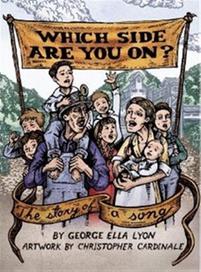
 George Ella Lyon (All the Water in the World) and Christopher Cardinale (Mister Mendoza's Paintbrush) make a perfect match for this picture-book homage to a 1931 rallying cry born under duress in Harlan County, Ky.
George Ella Lyon (All the Water in the World) and Christopher Cardinale (Mister Mendoza's Paintbrush) make a perfect match for this picture-book homage to a 1931 rallying cry born under duress in Harlan County, Ky.
Cardinale opens with a breathtaking view of the eastern Kentucky mountains. A church sits in the valley not far from a factory with coal cars filled to capacity and lined up on the rails as four children kick a can across the tracks. A turn of the page thrusts readers underground. "My Pa is a miner," says the text inside a burst of flame caused by the explosion that brings forth the coal. "Earns our dinner deep in the mountain blasting and loading coal," the text continues. The artist makes a smooth transition to a scene at the dinner table, where a family of nine passes plates of food; it's clear that no one goes hungry. Yet, they "live in a coal company house on coal company land," and the company pays Pa in scrip that has value only at the company store.
Lyon and Cardinale contextualize the terms so that a young audience can understand "scrip," "strike," "scab" and other ideas. They also do not shy away from the violence unleashed on the narrator's family. The girl explains that her Pa, Sam Reese, is a union organizer, and the company men would like to put an end to his organizing. As the sheriff and his gang shoot through the walls, the children hide under the bed while Ma--Florence Reece--tears off the calendar page for the month of May and uses it to compose the lyrics to the titular song, "Which side are you on?" Lyon maintains a child's point of view. As Ma sings her song, her children ask the questions that readers will have in mind: "Why don't the sheriff stop them?" and "If Pa gave up the union... would they quit shooting at us?" They provide the levity in a dire situation. Cardinale, too, balances the bullet-ravaged walls with those majestic Kentucky mountains.
In her endnotes, Lyon talks about the enduring quality and adaptability of folk songs: "Singers add their strengths and causes and make their own versions." She attributes her source for this story to Beverly Futrell, who heard it "from Reece herself" at Reece's 85th birthday party. Lyon points out that greed can take hold of both the owners and the unions at various times. She encourages children to "become informed" about issues of social justice, decide what they think and speak out. "We are how change happens." Although this book describes a historical event, it can open a gateway to understanding terms such as "collective bargaining," what that right has meant, and to consider what it means today. More recent versions of the song (performed by Pete Seeger and Natalie Merchant) add "boys" to the chorus ("Which side are you on, boys,/ which side are you on?"), Reese's version did not. Lyon and Cardinale make clear that the miner's entire family risked everything when they chose to stand together, male and female alike. And it's as powerful a message today as it was 80 years ago. --Jennifer M. Brown

